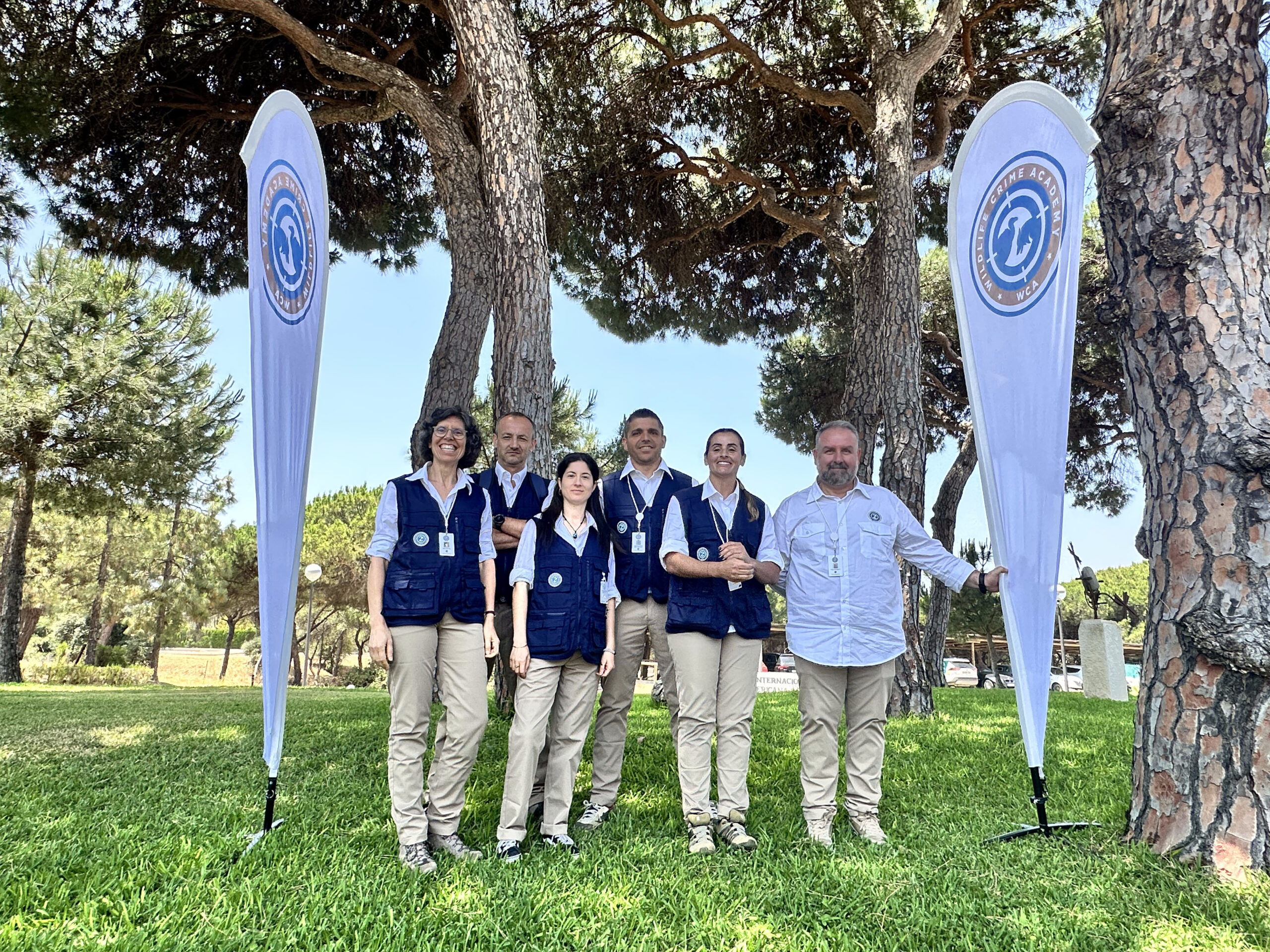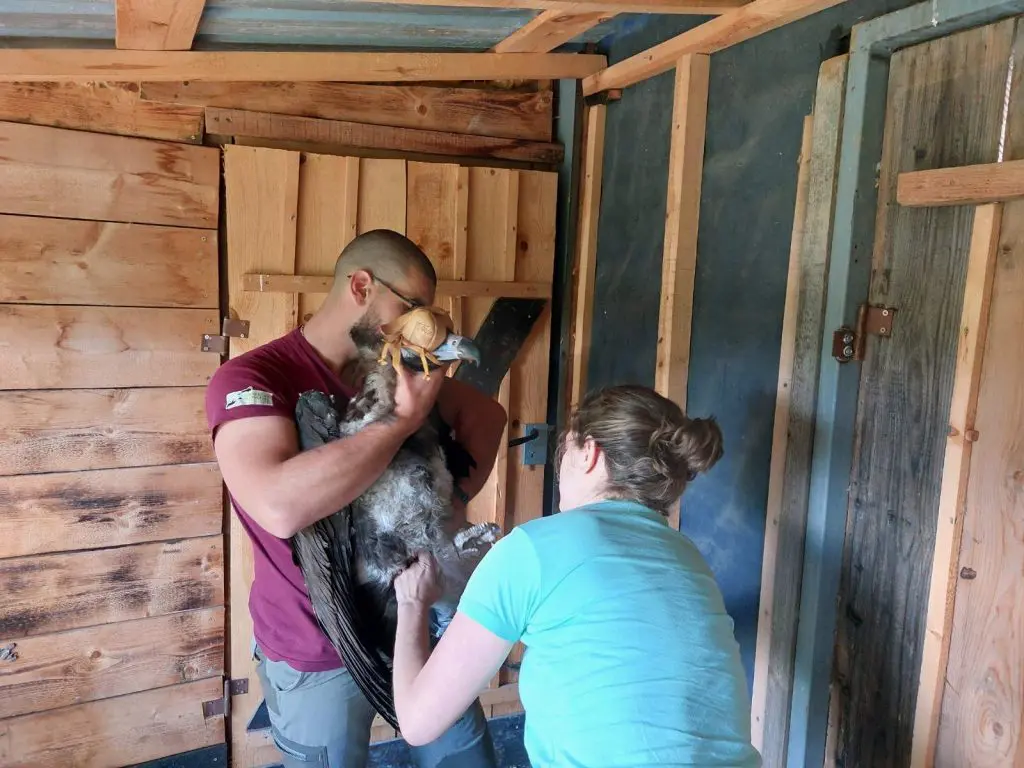Four Cinereous Vultures are set to strengthen Portugal’s most isolated breeding colony, having spent the last few months in an acclimatisation aviary at the Douro International Natural Park. This effort is one of the key actions as part of the LIFE Aegypius Return project that aims to consolidate and expand the population of the species in the country.




The four Cinereous Vultures that have been acclimatising in the Douro International ©Palombar
Meet the Cinereous Vultures
Arçã, Alfavaca, Azedinha and Almeirão: these are the names given to the four Cinereous Vultures (Aegypius monachus), three females and one male, that have spent the last few months in the acclimatisation cage built as part of the LIFE Aegypius Return project in the Douro International Natural Park, in Portugal. The cage was opened on Sunday, 3 November 2024, and, after a brief delay, they began their first expeditions outside the structure on Monday.
Names celebrate natural heritage
The names of the vultures were chosen by 7th graders from the Guerra Junqueiro School Group in Freixo de Espada à Cinta, during awareness-raising and environmental education activities on the project carried out by the Environmental Education Department and biologists from Palombar.


Environmental education and awareness-raising activities organised by Palombar at the Guerra Junqueiro School Grouping in Freixo de Espada à Cinta © Palombar
As they were the first vultures to be part of this soft release programme, they have all been given names beginning with the letter A. The names also allude to the region’s natural and cultural heritage:
Arçã: This is the name given in the region to a species of rosemary.
Alfavaca: An aromatic plant. The students chose this name because, as they explained, “this plant is used to treat infections and wounds. Just like the plant takes care of us, the Cinereous Vulture also takes care of everyone, as it is part of nature’s cleaning patrol.”
Azedinha: A name that alludes to the stomach of vultures, which is very acidic or sour (azedo in Portuguese).
Almeirão: A herbaceous plant native to southern Europe, which the students wanted to honour.
Vultures were rescued and rehabilitated in wildlife recovery centres
These four Cinereous Vultures inaugurated the acclimatisation cage built as part of the LIFE Aegypius Return project in Fornos, in the municipality of Freixo de Espada à Cinta, on a property owned by project partners ATN/Faia Brava.
All these vultures are juveniles, hatched in the wild (two in 2022 and two in 2023), which had been found weakened in various parts of the country. They were rescued and rehabilitated at various recovery centres: CARAS – Centro de Acolhimento e Recuperação de Animais Silvestres (Évora), two of them; another at CERAS – Centro de Estudos e Recuperação de Animais Selvagens (Castelo Branco) and another at CRASM – Centro de Recuperação de Animais Selvagens de Montejunto (Tojeira, Cadaval). Afterwards, they were all transferred to CERAS, where they finished their rehabilitation, and from there to the cage, which was inaugurated on 21 May 2024. The introduction of the vultures into the cage was accompanied by teams of veterinarians from CERAS and the Centre for the Recovery of Wild Animals at the Veterinary Hospital of the University of Trás-os-Montes and Alto Douro (CRAS/HV-UTAD), who also helped with the collection of biological samples and the placement of GPS/GSM transmitters.

Acclimatise to build loyalty
The acclimatisation cage was built with the aim of receiving Cinereous Vultures from wildlife rehabilitation centres, so that they can gradually adapt to the natural environment and become loyal to the region. The aim is to strengthen the Douro International cross-border breeding colony, which is quite fragile due to its small size and the fact that it is the most isolated of the Portuguese colonies. Through this soft release programme, the LIFE Aegypius Return project plans to return 20 Cinereous Vultures to the wild by 2027 in this protected area.

The timid return to freedom: the encouragement of the Cinereous Vulture Arribes and the adventures of a curious Griffon Vulture
On Sunday, 3 November 2024, the return of the four Cinereous Vultures to freedom was celebrated with an event open to the public, organised by Palombar. The event included a walk and various environmental awareness activities and was attended by around 30 people. The opening of the cage was observed from a great distance, from the Carrascalinho viewpoint, respecting the necessary tranquillity of the birds. Only a very small group of people travelled to the place where the structure is installed.
Following the procedures established for soft release, the birds are released with minimal contact with human beings, so as not to disturb them. The cage was opened by cattle breeder and shepherd Nélson Cordeiro, representing this sector which is fundamental to the conservation of the Cinereous Vulture, together with António Pinto, from the Lagoaça and Fornos Parish Council, who has been actively collaborating in raising awareness of the importance of vultures and their ecosystem services in the local community.


Once the cage is open, the vultures decide when they want to leave, without the intervention of the project technicians. The wait for them to leave turned out to be quite long! The four vultures decided to stay in the open cage for another night and didn’t leave until 11:21 am the following day, Monday, 4 November. Apparently, they needed the encouragement of Arribes, another wild juvenile Cinereous Vulture that was born this year in the Douro International colony and received a GPS/GSM transmitter. Arribes ended up entering the cage and “calling” his peers, who followed him outside very timidly. From outside, the whole scene was watched by a curious Griffon Vulture (Gyps fulvus), which came closer and closer and generated animosity between the five Cinereous Vultures. Arribes eventually flew away and the four vultures, on the threshold of the door, allowed the Griffon Vulture to enter the cage and feed on the scraps of meat that were still there. Little by little, the four vultures explored the outside environment and have already spent their first night back in freedom.



Little by little, the four vultures explored the outside environment and have already spent their first night back in freedom.

LIFE Aegypius Return partners would like to thank all the people and organisations involved in the acclimatisation procedures: veterinaries and recovery centres, the National Republican Guard (GNR) and the Nature and Environmental Protection Service – SEPNA, the Institute for Nature Conservation and Forests (ICNF) and their rangers, livestock farmers, technicians, the Lagoaça and Fornos Parish Council, the community of the Guerra Junqueiro School Group, and individual citizens who have participated in and supported the actions of the LIFE Aegypius Return project.
About LIFE Aegypius Return

The LIFE Aegypius Return project is co-financed by the European Union’s LIFE programme. Its success depends on the involvement of all the relevant stakeholders, and on the collaboration of the partners, the Vulture Conservation Foundation (VCF), the coordinating beneficiary, and the local partners Palombar – Conservation of Nature and Rural Heritage (with co-funding from Viridia – Conservation in Action and MAVA – Fondation pour la Nature), Herdade da Contenda, Sociedade Portuguesa para o Estudo das Aves, Liga para a Protecção da Natureza, Associação Transumância e Natureza, Fundación Naturaleza y Hombre, Guarda Nacional Republicana and Associação Nacional de Proprietários Rurais Gestão Cinegética e Biodiversidade.




